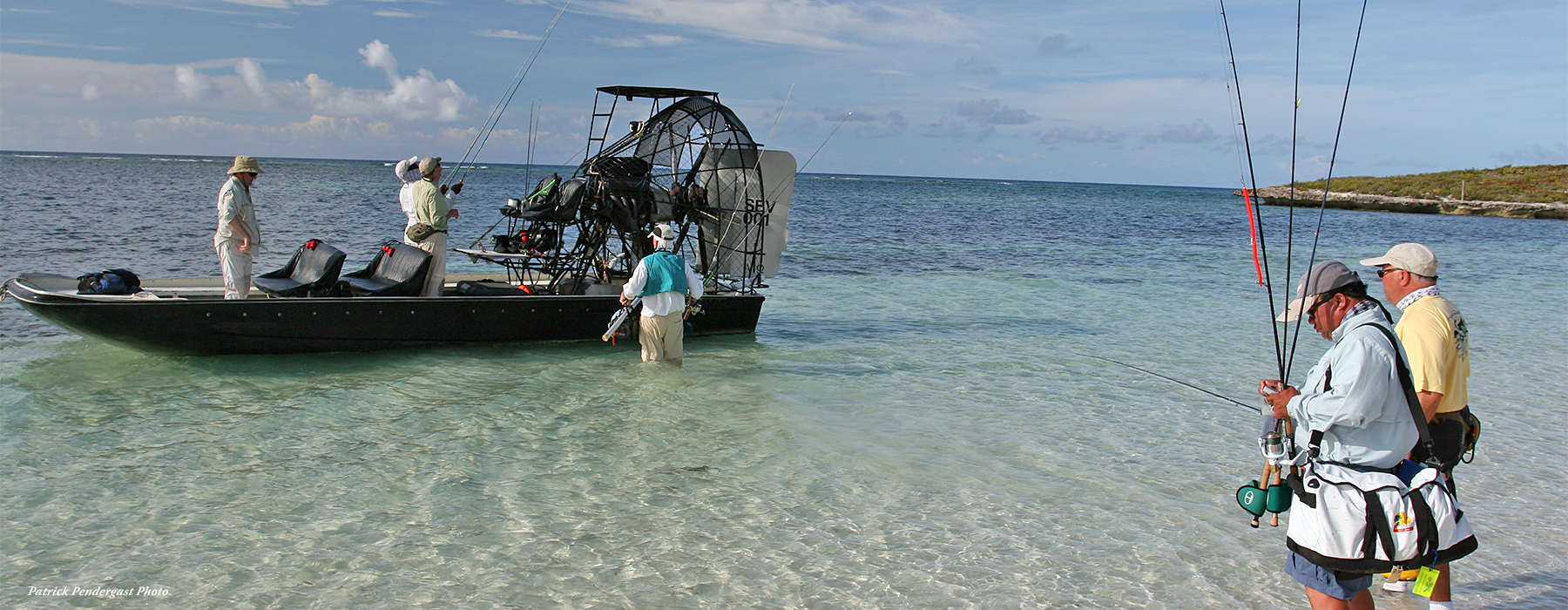“SOUTH”
A bonefish story from Turks & Caicos – British West Indies
By: Pat Pendergast
The roar of the big block Chevy 454 was near deafening as Garner, a.k.a. “G”, throttled down the un‐baffled beast of a V‐8, sending the airboat skidding into white sugar sand covered by a skinny five inches of water. Hordes of bonefish were still scattering like cockroaches suddenly exposed to light as fly rods were grabbed and five of my fishing pals poured over the gunnels like Marines storming off a landing craft on the beach of Iwo Jima in different directions onto a hard‐bottomed flat so perfectly bleached that it burnt the backs of my eyes. This was to be our first day of bonefishing South Caicos Island and I was dumbfounded by the 360° vista of nothing but shin‐high water covering dazzling white sand as far as my eyes could see.
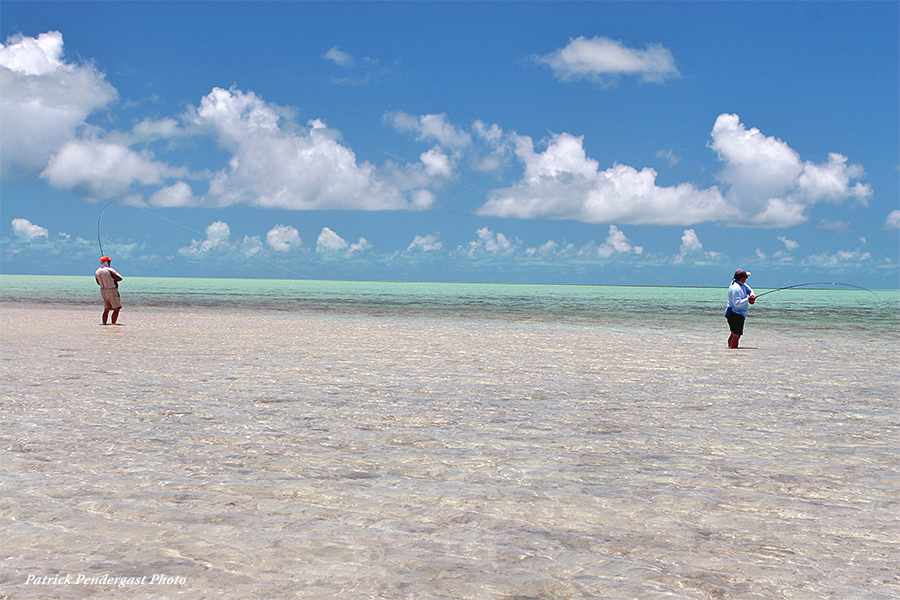
“Holy $#@t!” I said to myself, “this is absolutely amazing!” I was quickly shaken back to reality by “G” prodding me with the tip of my fly rod and saying, “…Pat, what‐da‐hell man, you need to go after them bones…”, so, jumping off the deck, I headed the opposite direction of the rest, scanning the seemingly endless flats around me. I was feeling a little guilty heading my own direction, but something told me to go this way and when you get that feeling, especially when fishing or hunting, you don’t argue. I had waded along for four or five minutes, when off to my right something caught my eye…a translucent fin! A closer look confirmed it to be a very nice‐sized bonefish lazily swimming my flank, oblivious to my presence, happily feeding as he went.
I maneuvered myself into position, legs shaking like a leaf (I was pumped!). I made my play when the fish was about fifty feet out, launching a cast in its general direction. Damn, I muttered, at least 12 feet off target. But to my astonishment, the big‐headed bone immediately switched direction, swam over to my fly, as if he owned the flat I was on, and on my first long strip postured, dorsal fin erect, and inhaled my #4 Squimp. I had enough composure to strip set, and the fish, feeling the hook…did nothing. What the hell, I thought, this is crazy! The bone swam around me once (quite apparently unaware of the hook fixed in its mouth, and the 17‐pound fluorocarbon leader tethering it to my reel), then lazily motored along his originally intended route. As the line came tight, I again put the bone to the bone ‐ still nothing! Finally, out of exasperation, I began banging the rod with my free hand, which immediately got the reaction I was looking for and it was off to the races ‐the fly line and half my backing was pulled through the guides at an astonishing rate. I survived the first run and then three more, each consecutively shorter though all into my backing, and had the fish at my feet, cradled in my hand, when the fly popped out. I estimated the fish (ironically, my biggest of the trip) between 7 and 8 pounds. “G” shouted out, “Nice bone, mon!” Wow, if this is how the rest of our trip was going to play out, we were in for one hell of a bonefishing adventure…
The rest of our day on the mega‐flats of South Caicos was not much different than the morning assault. We would tool around, circumnavigating the flats in the airboat until we intercepted consistent schools of bonefish, then bail out in hot pursuit to hound the fish until they either disappeared, or we got bored and wanted to exercise some new water.
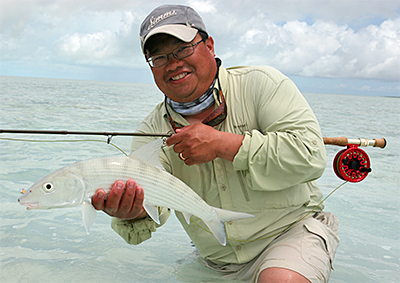 My friend John Chinuntdet (a hard‐core fisherman and hunter from North Carolina) planted the seed of South Caicos in my head. A buddy of his had made several trips to the British Territory and had nothing but rave reports: Big fish, gigantic flats and no outside intrusion from other guides or lodges. John and his close circle of fly fishing junkies wanted to go and he asked me to do the leg work and make it happen. I told him that the only way I was going plan the trip was if I could tag along. I had heard rumors and seen a couple low‐key articles on the Turks over the years, but relatively speaking it was one of those destinations that was well under the radar and that intrigued me even more. A few phone calls and a half a dozen Google searches and it was pretty apparent the island to go to was South Caicos ‐ “South” as the locals call it and the outfitter to work with was a fellow named Bibo Jayne, a Florida resident, transplant who had been fishing and outfitting on South for about decade. A flurry of emails and phone calls with Bibo and we had a date set, late May, 2011; this was April, 2010. We were all really wound up about our trip!
My friend John Chinuntdet (a hard‐core fisherman and hunter from North Carolina) planted the seed of South Caicos in my head. A buddy of his had made several trips to the British Territory and had nothing but rave reports: Big fish, gigantic flats and no outside intrusion from other guides or lodges. John and his close circle of fly fishing junkies wanted to go and he asked me to do the leg work and make it happen. I told him that the only way I was going plan the trip was if I could tag along. I had heard rumors and seen a couple low‐key articles on the Turks over the years, but relatively speaking it was one of those destinations that was well under the radar and that intrigued me even more. A few phone calls and a half a dozen Google searches and it was pretty apparent the island to go to was South Caicos ‐ “South” as the locals call it and the outfitter to work with was a fellow named Bibo Jayne, a Florida resident, transplant who had been fishing and outfitting on South for about decade. A flurry of emails and phone calls with Bibo and we had a date set, late May, 2011; this was April, 2010. We were all really wound up about our trip!
About the Turks:
Turks and Caicos is a British territory in the West Indies, east of Cuba, north of the Dominican Republic and Haiti and about 650 miles east, southeast of Miami at 21° North Latitude. Turks and Caicos is a string of many islands – eight major and close to 300 smaller islands – with a total land mass of about 240 square miles. The total population is about 45K with just about half that number living on the main island of Providenciales (called Provo by the locals) where you clear immigrations and customs and is the main resort island of the nation.
The first inhabitants of the Turks date back to AD 700, and Christopher Columbus is credited with being the first European to set foot on Guanahani Beach on the capital island of Grand Turk in 1492. Pirates, preying on Spanish Galleons moving through and between the Caribbean and South America used the Turks and Caicos as a hideout in the late 1600’s and early 1700’s. The island changed hands between the French, British and Spanish and later was controlled and hotly contested by Bermuda, the Bahamas and finally Jamaica. Not until Jamaica gained its independence from Great Britain in the early sixties did the Turks and Caicos Islands became an official crown colony of Britain and the governor of The Bahamas was appointed the acting governor. When the Bahamas gained independence from Britain in 1973, the Turks finally received their own governor. In the 1970’s Canada strongly argued for a formal union with Turks and Caicos, but nothing came of it. Over the last 30 years Turks and Caicos has struggled through many political maneuvers by local politicians, however rampant corruption has kept Great Britain fully engaged in the political arena and island government affairs and ruling.
Nowadays Turks and Caicos’ economy is fueled by tourism, primarily centered on the island of Provo, with most tourists travelling from the U.S and Canada. Outside of tourism the main industries of the Turks include commercial harvest of spiny lobster, conch and commercial fishing on the reef and outside over the deep blue.
On South Caicos, where our bonefish adventure took place, there is not much happening in the way of industry. In fact Bibo has the only sport fishing operation on the island. But there are a lot of bonefish and miles upon miles of idyllic white sands flats, perfect for wading and stalking tailing fish.
Skinny, Skinny Water:
It was the afternoon of our third day, after lunch and a pretty productive morning, although we had to search, quite a bit more than the previous two days to find good numbers of bonefish. The tide was ebbing and as we scooted along a deep water trough, one of the few we saw all week, a white sand island appeared and “G” spotted a nice school of bonefish from his airboat perch, in the lee of the island. The guys bailed out of the boat and scattered like a covey of flushed quail and were soon at work hooking bones and having a good time of it. I watched the action for 5 minutes or so and asked “G” where to? He said, “…Pat you know man, into the wind, the way you always fish, there could be some big bones coming out of the cut to the northeast.
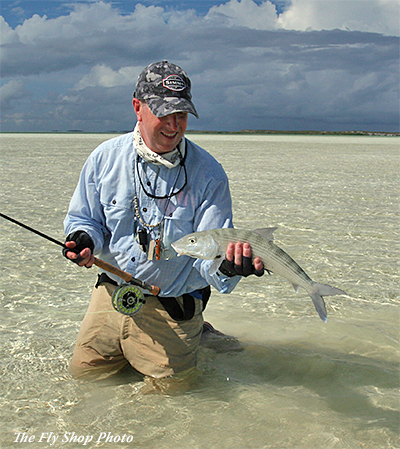 I grabbed my rod and fanny pack and started trekking up this dry, white sand strip bordered by a knee‐high turtle‐grass, hummock‐flat to the east and Ty‐d‐bowl blue, deep water trench to the west. I walked a good half mile without seeing a fish and noticed John had broken from the pack and was flanking me to the east, out a couple hundred yards, headed in the same direction. The dry sand strip I was walking on ran out and soon a 75 yards wide and 400 yards long, perfectly white sand flat, ankle deep, came into view. Toward the top, across the belly of the flat all I could see were tails of bonefish glistening in the sun. I slowed my pace and started waiving John over, who was already on a fast track toward my direction. When we got together – we were both jazzed and I remember saying to John, “…this is what it’s all about, dozens of tailing bones, on an immaculate white sugar flat, it doesn’t get any better…” We slowly made our way toward the fish, crouching as low as we could, damn near crawling on our hands and knees to within striking distance. In the span of about 20 minutes, John and I had three doubles and at one point we were both sitting on our butts in three inches of water (an effort to keep from spooking the continuing stream of bones that kept surfing up on the flat from the deep trough), each with a bonefish on, laughing like 10 year old boys – having a very big time of it.
I grabbed my rod and fanny pack and started trekking up this dry, white sand strip bordered by a knee‐high turtle‐grass, hummock‐flat to the east and Ty‐d‐bowl blue, deep water trench to the west. I walked a good half mile without seeing a fish and noticed John had broken from the pack and was flanking me to the east, out a couple hundred yards, headed in the same direction. The dry sand strip I was walking on ran out and soon a 75 yards wide and 400 yards long, perfectly white sand flat, ankle deep, came into view. Toward the top, across the belly of the flat all I could see were tails of bonefish glistening in the sun. I slowed my pace and started waiving John over, who was already on a fast track toward my direction. When we got together – we were both jazzed and I remember saying to John, “…this is what it’s all about, dozens of tailing bones, on an immaculate white sugar flat, it doesn’t get any better…” We slowly made our way toward the fish, crouching as low as we could, damn near crawling on our hands and knees to within striking distance. In the span of about 20 minutes, John and I had three doubles and at one point we were both sitting on our butts in three inches of water (an effort to keep from spooking the continuing stream of bones that kept surfing up on the flat from the deep trough), each with a bonefish on, laughing like 10 year old boys – having a very big time of it.
Flamingo Point:
Another extremely memorable bonefish sortie took place our last day of fishing. It was late morning and we had been having fairly good luck on some mottled bottom, mid‐calf high flats, but we were playing cat & mouse with clouds and looking into the sun. Seeing fish on such a bottom was really tough. We decided to take the airboat north, toward East Caicos, further than we had been the previous three days, and poke around the entrance of an extensive mangrove‐lined creek system. The entrance to this maize of channels, peninsulas and islands was bordered by a whoop‐di‐doo‐laden turtle grass flat to the west, a deepwater channel to the south connected to a going‐through to the deep blue Atlantic, sandwiched by high rock bluffs.
No sooner had the airboat come off the step and shuddered to a stop when a school of bonefish was spotted and the guys were on them like a duck on a Junebug. Dick Lang and I decided to head up bleach blonde sand flat that bordered a mangrove‐studded island toward the going‐through. There were good numbers of sharks on the strip‐flat (a usual sign that bonefish are nearby) and as we rounded the corner and started walking back toward the direction we came from, but on the inside of the island, we looked across a channel toward a tiny talc‐white flat where dozens of bonefish tails wagged. An unbroken chain of bones were coming off the near impossible‐to‐navigate and see‐fish‐on, turtle grass flat. The fish swam upstream, into a strong tidal flow, reminiscent of tundra silver salmon rivers I had fished in Alaska – it was wild.
Just about every fish stopped at this tiny flat for a snack, before heading into the maze of creek channels and flooded mangroves. Dick and I were in perfect position and we began to pick the fish off one at a time and after several fish hooked and very few landed, our cover was blown and the fish started to make an end‐run on us. It was an amazingly beautiful track of saltwater wilderness, a complexity of different palatable textures and elevations, accented by a saturation of contrasting colors all cumulating into a single visual canvas pulsating with life. This extraordinary little piece of “South” will forever be etched in my – it was truly special.
Equipment:
One of the nicest aspects of a bonefishing trip – (and for that matter any saltwater fly fishing trip) – is the equipment you need to assemble and pack is relatively simple and compact. In my case I carried a seven and eight weight fly rod, Scott S4s saltwater models, 9 foot in length. One was rigged with a Nautilus NV 8/9 and the other an Abel Super 8, both lined with Scientific Anglers Mastery Sharkskin Saltwater floating line. These fish are NOT leader shy: 9 foot Seaguar Fluorocarbon leaders tapered between 15 – 17 pounds was what I had and used.
Flies were just as straightforward as the rest of my equipment. A #4 Squimp worked well in most cases, but a #2 standard Gotcha produced the best. Other flies I had luck on were a #4 Pink Puff, #4 white, Nasty Charlie, a #2 Magnum Mantis Shrimp and a #4 Enrico’s Spawning Shrimp (translucent). Light tan, white or off‐white patterns are the colors to lean toward when assembling a fly selection for South. Very nice barracuda are prevalent on the flats of South and everyone we threw to ate! If you want to have some ‘cuda‐fun, bring some wire tippet and a few Paulson’s Ka‐Cudda flies.
Expect to be on your feet in the water walking for better than 8 hours a day while hunting bones on South Caicos. Be sure to bring well fitted and broken in wading booties or boots with heavy duty soles. You’ll also want to bring a couple pair of lightweight socks to wear under your wading boots to help keep sand out and prevent blisters. Gravel guards are not a bad idea either.
The flats of South Caicos are wide open with little if any shade within miles. Be sure to bring a good hat that offers plenty of face and neck coverage. I wore a Buff® as well sun‐gloves for added sun protection. And, of course, bring plenty of Sunscreen, waterproof, UVA, UVB, paba free with some physical block like zinc oxide SPF 30+. Apply the sunscreen in the morning before breakfast and reapply after lunch. Do not underestimate the sun’s intensity; it will cook you if you let it!
Lastly, I wore lightweight, quick drying pants by Patagonia and Simms long sleeve Solarflex shirts. Both performed admirably. For carrying my camera, fly box, lens cloth, lip balm, extra leaders, and all that other gear we convince ourselves to carry while fishing I used my Sagebrush fanny pack, 100% waterproof; it’s one of my favorite and most utilized pieces of equipment I own.
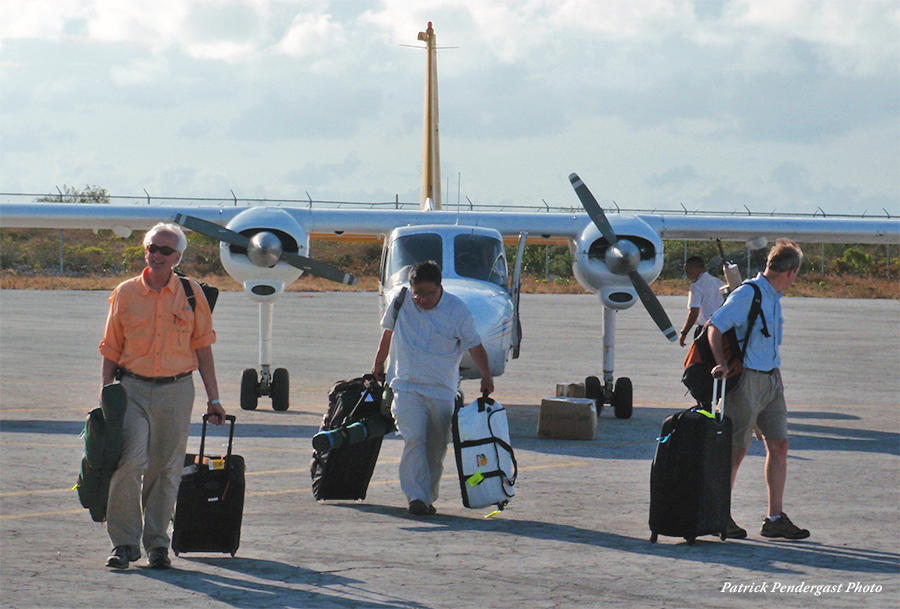
Getting There:
Getting to Turks & Caicos is relatively painless, especially from the Midwest or Eastern seaboard. American Airlines offers three daily flights from Miami, and once a day service from JFK as well as direct flights from Boston. Delta offers six‐times a week service from Atlanta and US Airways offers daily flights from Charlotte, Boston and Philadelphia. Air Canada offers direct flights from Toronto, Montreal, and Ottawa. Coming from the west coast, I caught a non‐stop Delta red‐eye flight from Sacramento to Atlanta arriving in the morning with enough time for breakfast, connecting on another Delta flight to Provo, a short 2 hour jaunt. A valid Passport is mandatory for entry into Turks and Caicos and return into the States. All flights arrive and depart from the nation’s only international Airport Providenciales, airport code PLS. Immigrations and Customs is simple, quick and a pleasant experience, with friendly government officials.
From Provo you will want to arrange for a seat on one of Air Turks & Caicos’ three daily scheduled flights to South Caicos, airport code XSC. Cost of the roundtrip flight is about $140 USD. The flight to South from Provo takes about 30 minutes and really gives you a bird’s eye view of the island chain and expansive waterways. When you land in South, you will be met by Bubba, the taxi driver Bibo is hooked up with, and driven to the lodge, a short 10 minute drive. If you want beer or an adult beverage, Bubba will stop by Ms. Leah’s house where you can purchase beer, rum, vodka or gin. Booze is expensive on South: a case of Coors Lite cost $45, same for Heineken. Bring cash, as Ms. Leah does not accept credit cards or checks. By the way, the official currency of the Turks is the U.S. Dollar – very handy.
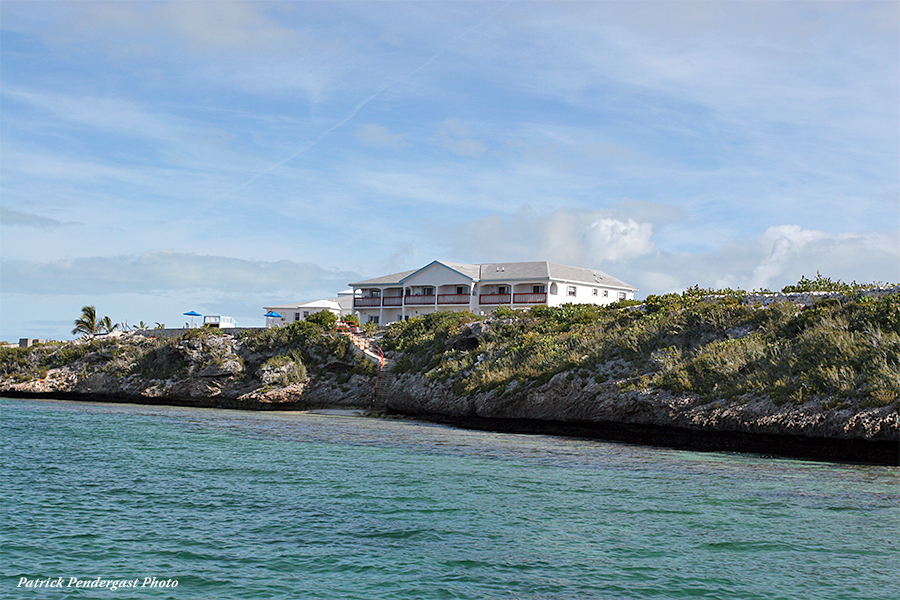
Lodging:
The lodging for Beyond the Blue consists of three air‐conditioned, two story townhouses nestled on a high limestone overlook facing the Atlantic Ocean to the south. The view is spectacular! Each townhouse has two, double occupancy bedrooms, each with its own ensuite bathroom with shower/tub, toilet, sink and vanity with hot water. The bedrooms are spacious featuring two full size beds, a ceiling fan, air conditioner, large closet, and outside veranda with terrific ocean views. All the linens are supplied and daily maid service by Ms. Magda is part of the package. Down stairs are a living room, kitchen and dining room. The townhouses are a short three minute walk from where you catch the airboat. The accommodations are nothing fancy, but quite nice, plenty comfortable, clean, well laid out and spacious – just right for a fishing trip. After‐fishing beers and before and after dinner cocktails are taken outside overlooking the ocean and reef beyond.
Meals at Beyond the Blue can only be described as absolutely delicious: a hybrid mix of Deep South comfort food and Creole fare, painstakingly prepared by two wonderful and colorful local ladies. Pearl is the morning cook and serves up a full‐on southern breakfast, including her famous conch and cheese grits which are to die for! Olive is the evening cook and her evening hors d’œuvres, like the light and fluffy, conch fritters we gorged on and fresh seared tuna steaks are just a few of the dishes she specializes in. Plenty of fresh fish, conch, meats, fresh vegetables, fruit and accompanying starches are what to expect.
Expect Full Days:
A typical day had fresh ground coffee brewing at 6:00 a.m. followed by a hearty breakfast buffet ready by 7:00 a.m. After breakfast we took a short walk down hill, to the airboat. We left the beach no later than 8:00 a.m. and most rides to
the flats took no longer than 5 ‐20 minutes.
Lunch is taken on the fly on the fishing grounds and consists of sandwiches (some of the best I have ever eaten at any fishing lodge), chips, cookies and fruit. Plenty of iced‐down soft drinks and bottled water are stocked in the cooler each day. We were usually back on the beach at approximately 4:30 p.m., although on a couple days we weren’t back to the beach until 5:30 p.m. You get a very full day of fishing.
You’ll be back at the lodge in plenty of time to take a shower, enjoy an adult beverage and feast on some conch fritters, before a delicious dinner is served at 7:30 p.m. or so.
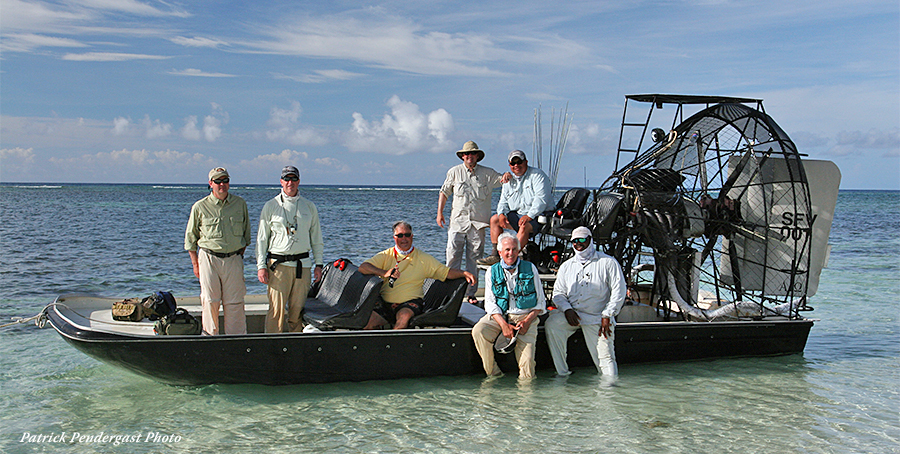
The typical season on South Caicos is November through June. Normal trade winds are manageable at 10 – 15 knots and from the south east and most of the flats have the added advantage of being in the lee of the wind on the west side of the island. During fall and winter months South can get some cold fronts coming down from the Bahamas, but they push through real hard and don’t linger long and are mostly dissipated by the time they hit. After a cold front you might get a west wind for a day, then turning to the normal south east. Interesting too, and very significant is that even in severe winds, in excess of 35 plus knots, during a strong storm or tropical depression, the flats remain clear – no milking‐up and the flats and the fish are on. This phenomenon is extremely rare in the saltwater fly fishing world; a real bonus and could save a trip during an inclement weather period.
The true litmus test of any great fly fishing destination, is whether you would return. As we sat on the precipice in front of the lodge, overlooking the Atlantic, after dinner, intermittent flashes of lightning illuminated the black night hundreds of miles away, I posed the questions to my new friends, “…would you come back…” and it was a resounding “Yes, absolutely!” You must take into account that these are seasoned anglers that have fished all over the world, fresh and salt, for many, many years and are in a life‐position to go anywhere they want, at any time, regardless of cost… “Why?” “… massive wadeable flats that go forever, great average size bonefish that are willing to eat just about anything you throw at ’em and NO other fishermen around!”
Special Note:
South is not a destination for beginner fly fishers and you should be competent in your saltwater fly-fishing abilities. You must be a self-reliant angler, who doesn’t need to be constantly coached by a guide and have someone on your shoulder giving instruction. You need to be able to walk ALL day on beautiful flats that are for the most part are hard and flat. But there are also flats that are soft with hummocks and relatively difficult to wade. That said you should be in some sort of reasonable shape to best take advantage of the fishing opportunities.
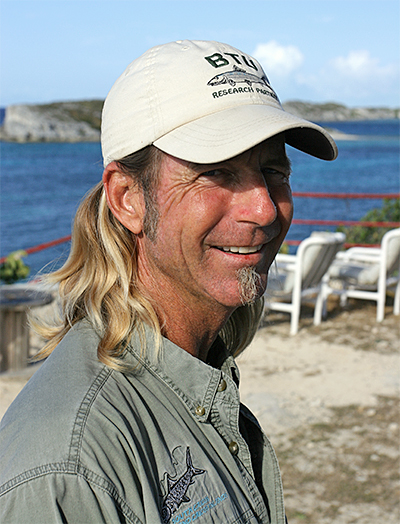 The Outfitter:
The Outfitter:
Bibo Jayne is a tall thin fellow with sun‐bleached blonde hair, a dark tan, warm inviting smile, and an easy, comfortable way about him. Bibo was born and raised in south west Florida and cut his teeth chasing back country snook in his youth while being destroyed by mosquitoes in the 10,000 islands region, now a National Wildlife Refuge. It was back in the mid-eighties, while delivering a motor yacht to Tortola in the British Virgin Islands, on a fuel stop, that Bibo first stepped onto South Caicos. “… there was nothing much back then, few buildings, fewer people, a whole lot of nothing” said Bibo. Bibo found his way back to South in 1990 working as a site manager for the School for Field Studies Marine research facility. Bibo’s residency on South gave him the time to investigate the massive flats and surrounding bights and creeks.
Bibo wanted to make certain that the numbers of bonefish he discovered were not an aberration and that there was indeed a sustainable resource that would support a small sport fishing operation, while leaving the smallest footprint on the environment as possible, which by the way, was the reason he purchased and shipped an airboat to South, the only means of navigating the shallow flats without tearing up the bottom. Back‐to‐back years of intensive field testing of the fishery in 1995 and 1996, led to the official soft‐opening of his operation in 1999. Since that time, Bibo has not looked back and he and his wife Marian and their three sons, spend better than six months a year hosting hardcore flats fishermen from around the world at their wonderful little piece of bonefish paradise.


